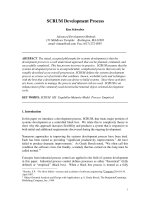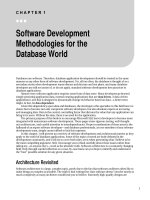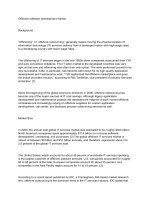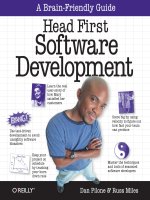Software development process
Bạn đang xem bản rút gọn của tài liệu. Xem và tải ngay bản đầy đủ của tài liệu tại đây (124.39 KB, 8 trang )
Software development process
Software development
process
Bởi:
Hung Vo
A software development process is a structure imposed on the development of a
software product. Synonyms include software lifecycle and software process. There are
several models for such processes, each describing approaches to a variety of tasks or
activities that take place during the process.
Processes and meta-processes
A growing body of software development organizations implement process
methodologies. Many of them are in the defense industry, which in the U.S. requires
a rating based on 'process models' to obtain contracts. The international standard for
describing the method of selecting, implementing and monitoring the life cycle for
software is ISO 12207.
The Capability Maturity Model (CMM) is one of the leading models. Independent
assessments grade organizations on how well they follow their defined processes,
not on the quality of those processes or the software produced. CMM is gradually
replaced by CMMI. ISO 9000 describes standards for formally organizing processes
with documentation.
ISO 15504, also known as Software Process Improvement Capability Determination
(SPICE), is a "framework for the assessment of software processes". This standard is
aimed at setting out a clear model for process comparison. SPICE is used much like
CMM and CMMI. It models processes to manage, control, guide and monitor software
development. This model is then used to measure what a development organization or
project team actually does during software development. This information is analyzed
to identify weaknesses and drive improvement. It also identifies strengths that can be
continued or integrated into common practice for that organization or team.
1/8
Software development process
Process activities/steps
DesignOperation
andPlanningTesting
andMaintenanceRequirementImplementationFeasibility
1. Requirements analysis: The most important task in creating a software product is
extracting the requirements. Customers typically know what they want, but not what
software should do, while incomplete, ambiguous or contradictory requirements are
recognized by skilled and experienced software engineers. Frequently demonstrating
live code may help reduce the risk that the requirements are incorrect.
The system's services, constraints and goals are established by consultation with system
users. They are then defined in a manner that is understandable by both users and
development staff.
This phase can be divided into:
•
•
•
•
Feasibility study (often carried out separately)
Requirements analysis
Requirements definition
Requirements specification
2. Design
• System design: Partition the requirements to hardware or software systems.
Establishes an overall system architecture. The architecture of a software
system refers to an abstract representation of that system. Architecture is
concerned with making sure the software system will meet the requirements of
the product, as well as ensuring that future requirements can be addressed. The
architecture step also addresses interfaces between the software system and
other software products, as well as the underlying hardware or the host
operating system.
• Software design: Represent the software system functions in a form that can be
transformed into one or more executable programs. Specification is the task of
precisely describing the software to be written, possibly in a rigorous way. In
practice, most successful specifications are written to understand and fine-tune
applications that were already well-developed, although safety-critical software
systems are often carefully specified prior to application development.
Specifications are most important for external interfaces that must remain
stable.
3. Implementation (or coding): Reducing a design to code may be the most obvious
part of the software engineering job, but it is not necessarily the largest portion. An
2/8
Software development process
important (and often overlooked) task is documenting the internal design of software for
the purpose of future maintenance and enhancement. Documentation is most important
for external interfaces.
4. Testing: Testing of parts of software, especially where code by two different
engineers must work together, falls to the software engineer.
6. Operation and maintenance: A large percentage of software projects fail because
the developers fail to realize that it doesn't matter how much time and planning a
development team puts into creating software if nobody in an organization ends up using
it. People are occasionally resistant to change and avoid venturing into an unfamiliar
area, so as a part of the deployment phase, its very important to have training classes
for the most enthusiastic software users (build excitement and confidence), shifting
the training towards the neutral users intermixed with the avid supporters, and finally
incorporate the rest of the organization into adopting the new software. Users will have
lots of questions and software problems which leads to the next phase of software.
Maintaining and enhancing software to cope with newly discovered problems or new
requirements can take far more time than the initial development of the software.
Not only may it be necessary to add code that does not fit the original design but
just determining how software works at some point after it is completed may require
significant effort by a software engineer. About ⅔ of all software engineering work is
maintenance, but this statistic can be misleading. A small part of that is fixing bugs.
Most maintenance is extending systems to do new things, which in many ways can be
considered new work. In comparison, about ⅔ of all civil engineering, architecture, and
construction work is maintenance in a similar way.
Process models
A decades-long goal has been to find repeatable, predictable processes or methodologies
that improve productivity and quality. Some try to systematize or formalize the
seemingly unruly task of writing software. Others apply project management techniques
to writing software. Without project management, software projects can easily be
delivered late or over budget. With large numbers of software projects not meeting
their expectations in terms of functionality, cost, or delivery schedule, effective project
management is proving difficult.
Waterfall process
In 1970 Royce proposed what is presently referred to as the waterfall model as an initial
concept, a model which he argued was flawed (Royce 1970). His paper then explored
how the initial model could be developed into an iterative model, with feedback from
each phase influencing subsequent phases, similar to many methods used widely and
highly regarded by many today. It is only the initial model that received notice; his own
3/8
Software development process
criticism of this initial model has been largely ignored. The "waterfall model" quickly
came to refer not to Royce's final, iterative design, but rather to his purely sequentially
ordered model. This article will use this popular meaning of the phrase waterfall model.
For an iterative model similar to Royce's final vision, see the spiral model.
Despite Royce's intentions for the waterfall model to be modified into an iterative
model, use of the "waterfall model" as a purely sequential process is still popular, and,
for some, the phrase "waterfall model" has since come to refer to any approach to
software creation which is seen as inflexible and non-iterative. Those who use the phrase
waterfall model pejoratively for non-iterative models that they dislike usually see the
waterfall model itself as naive and unsuitable for a "real world" process.
The best-known and oldest process is the waterfall model, where developers (roughly)
follow these steps in order:
Process activities/steps
To follow the waterfall model, one proceeds from one phase to the next in a purely
sequential manner. For example, one first completes "requirements specification" —
they set in stone the requirements of the software. When the requirements are fully
completed, one proceeds to design. The software in question is designed and a
"blueprint" is drawn for implementers (coders) to follow — this design should be a
plan for implementing the requirements given. When the design is fully completed,
4/8
Software development process
an implementation of that design is made by coders. Towards the later stages of this
implementation phase, disparate software components produced by different teams are
integrated. After the implementation and integration phases are complete, the software
product is tested and debugged; any faults introduced in earlier phases are removed
here. Then the software product is installed, and later maintained to introduce new
functionality and remove bugs.
Thus the waterfall model maintains that one should move to a phase only when its
preceding phase is completed and perfected. Phases of development in the waterfall
model are thus discrete, and there is no jumping back and forth or overlap between them.
There is a misconception that the process has no provision for correcting errors in early
steps (for example, in the requirements). In fact this is where the domain of requirements
management comes in which includes change control.
This approach is used in high risk projects, particularly large defense contracts. The
problems in waterfall do not arise from "immature engineering practices, particularly
in requirements analysis and requirements management." Studies of the failure rate of
the specification, which enforced waterfall, have shown that the more closely a project
follows its process, specifically in up-front requirements gathering, the more likely the
project is to release features that are not used in their current form.
More often too the supposed stages are part of joint review between customer and
supplier, the supplier can, in fact, develop at risk and evolve the design but must sell
off the design at a key milestone called Critical Design Review (CDR). This shifts
engineering burdens from engineers to customers who may have other skills.
The waterfall model however is argued by many to be a bad idea in practice, mainly
because of their belief that it is impossible to get one phase of a software product's
lifecycle "perfected" before moving on to the next phases and learning from them (or,
at least, the belief that this is impossible for any non-trivial program). For example,
clients may not be aware of exactly what requirements they want before they see
a working prototype and can comment upon it; they may change their requirements
constantly, and program designers and implementers may have little control over this.
If clients change their requirements after a design is finished, that design must be
modified to accommodate the new requirements, invalidating quite a good deal of
effort if overly large amounts of time have been invested into "Big Design Up Front".
(Thus, methods opposed to the naive waterfall model--such as those used in Agile
software development--advocate less reliance on a fixed, static requirements document
or design document). Designers may not (or, more likely, cannot) be aware of future
implementation difficulties when writing a design for an unimplemented software
product. That is, it may become clear in the implementation phase that a particular area
of program functionality is extraordinarily difficult to implement. If this is the case, it is
5/8
Software development process
better to revise the design than to persist in using a design that was made based on faulty
predictions and that does not account for the newly discovered problem areas.
The idea behind the waterfall model may be "measure twice; cut once", and those
opposed to the waterfall model argue that this idea tends to fall apart when the problem
being measured is constantly changing due to requirement modifications and new
realizations about the problem itself. The idea behind those who object to the waterfall
model may be "time spent in reconnaissance is seldom wasted".
In summary, the criticisms of a non-iterative development approach (such as the
waterfall model) are as follows:
• Many software projects must be open to change due to external factors; the
majority of software is written as part of a contract with a client, and clients are
notorious for changing their stated requirements. Thus the software project
must be adaptable, and spending considerable effort in design and
implementation based on the idea that requirements will never change is neither
adaptable nor realistic in these cases.
• Unless those who specify requirements and those who design the software
system in question are highly competent, it is difficult to know exactly what is
needed in each phase of the software process before some time is spent in the
phase "following" it. That is, feedback from following phases is needed to
complete "preceding" phases satisfactorily. For example, the design phase may
need feedback from the implementation phase to identify problem design areas.
The counter-argument for the waterfall model is that experienced designers
may have worked on similar systems before, and so may be able to accurately
predict problem areas without time spent prototyping and implementing.
• Constant testing from the design, implementation and verification phases is
required to validate the phases preceding them. Constant "prototype design"
work is needed to ensure that requirements are non-contradictory and possible
to fulfill; constant implementation is needed to find problem areas and inform
the design process; constant integration and verification of the implemented
code is necessary to ensure that implementation remains on track. The counterargument for the waterfall model here is that constant implementation and
testing to validate the design and requirements is only needed if the
introduction of bugs is likely to be a problem. Users of the waterfall model may
argue that if designers (et cetera) follow a disciplined process and do not make
mistakes that there is no need for constant work in subsequent phases to
validate the preceding phases.
• Frequent incremental builds (following the "release early, release often"
philosophy) are often needed to build confidence for a software production
team and their client.
6/8
Software development process
• It is difficult to estimate time and cost for each phase of the development
process without doing some "recon" work in that phase, unless those estimating
time and cost are highly experienced with the type of software product in
question.
• The waterfall model brings no formal means of exercising management control
over a project and planning control and risk management are not covered
within the model itself.
• Only a certain number of team members will be qualified for each phase; thus
to have "code monkeys" who are only useful for implementation work do
nothing while designers "perfect" the design is a waste of resources. A counterargument to this is that "multiskilled" software engineers should be hired over
"specialized" staff.
Iterative process
Iterative process
Iterative development prescribes the construction of initially small but ever larger
portions of a software project to help all those involved to uncover important issues
early before problems or faulty assumptions can lead to disaster. Iterative processes are
preferred by commercial developers because it allows a potential of reaching the design
goals of a customer who does not know how to define what they want.
While Iterative development approaches have their advantages, software architects are
still faced with the challenge of creating a reliable foundation upon which to develop.
Such a foundation often requires a fair amount of upfront analysis and prototyping to
build a development model. The development model often relies upon specific design
patterns and entity relationship diagrams (ERD). Without this upfront foundation,
Iterative development can create long term challenges that are significant in terms of
cost and quality.
7/8
Software development process
Critics of iterative development approaches point out that these processes place what
may be an unreasonable expectation upon the recipient of the software: that they must
possess the skills and experience of a seasoned software developer. The approach can
also be very expensive if iterations are not small enough to mitigate risk; akin to... "If
you don't know what kind of house you want, let me build you one and see if you like
it. If you don't, we'll tear it all down and start over." By analogy the critic argues that
up-front design is as necessary for software development as it is for architecture. The
problem with this criticism is that the whole point of iterative programming is that you
don't have to build the whole house before you get feedback from the recipient. Indeed,
in a sense conventional programming places more of this burden on the recipient, as the
requirements and planning phases take place entirely before the development begins,
and testing only occurs after development is officially over.
These approaches have been developed along with web based technologies. As such,
they are actually more akin to maintenance life cycles given that most of the architecture
and capability of the solutions is embodied within the technology selected as the back
bone of the application.
References:
/> />OcwWeb/Electrical-Engineering-and-Computer-Science/6-171Fall2003/CourseHome/,
/> />computing/resources/IanS/SE7/, />IntroToSoftwareEng.htm,
/> etc...
8/8









